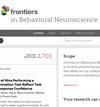Impairments of social interaction in a valproic acid model in mice
IF 2.6
3区 医学
Q2 BEHAVIORAL SCIENCES
引用次数: 0
Abstract
BackgroundA rodent autism spectrum disorder (ASD) model based on prenatal exposure to valproic acid (VPA) is widely recognized as a prominent model. Social behavior in rodent ASD models has primarily been evaluated through a three-chamber approach test. However, in this study, we focused on social attention in the VPA model of ASD.MethodsIn male C57BL/6 J mice, attentional behaviors toward conspecifics were examined through reaching tasks around 9–11 weeks of age. On embryonic day 12.5, pregnant mice underwent a subcutaneous injection of 600 mg/kg VPA sodium salt dissolved in 0.9% saline solution (VPA group) or saline solution alone (Sal group) into their neck fat. Thirty-six mice—nine each in the VPA and saline groups, and 18 partners—underwent training in reaching behavior. Subsequently, we examined whether the VPA or Sal group demonstrated focused attention toward their partners during reaching tasks. A two-way analysis of variance (ANOVA) (condition [VPA/Sal] × situation [face-to-face (attention)/not paying attention (not attention)]) was conducted on the average success rate of the situation. Additionally, we measured the duration of sniffing behavior between pairs of mice in an open field twice in total at 4 and 8 weeks of age before reaching task. The pairs were constructed by pairing a VPA or Sal group mouse with its partner, with the objective of facilitating initial encounters between the mice. A one-way ANOVA was conducted on the average duration of sniffing behavior data from 4 weeks and a second one-way ANOVA on data from 8 weeks.ResultsThe analysis revealed a significant interaction between condition and situation in the reaching task [丙戊酸模型小鼠的社会交往障碍
背景一种基于产前接触丙戊酸(VPA)的啮齿类自闭症谱系障碍(ASD)模型被公认为是一种杰出的模型。啮齿类 ASD 模型的社交行为主要通过三室接近测试进行评估。方法在雄性 C57BL/6 J 小鼠中,我们通过 9-11 周龄左右的触及任务检测了它们对同种动物的注意行为。在胚胎第 12.5 天,怀孕小鼠的颈部脂肪皮下注射 600 毫克/千克溶于 0.9% 生理盐水的 VPA 钠盐(VPA 组)或仅注射生理盐水(Sal 组)。36只小鼠(VPA组和生理盐水组各9只)和18只伙伴小鼠接受了伸手行为训练。随后,我们考察了 VPA 组或盐水组小鼠在完成伸手任务时是否表现出对伙伴的集中注意。我们对情境的平均成功率进行了双向方差分析(ANOVA)(条件 [VPA/Sal] × 情境 [面对面(注意)/不注意(不注意)])。此外,我们还测量了到达任务前 4 周龄和 8 周龄的成对小鼠在空旷场地嗅闻行为的持续时间,共计两次。这对小鼠是由 VPA 或 Sal 组小鼠与其伙伴配对而成,目的是促进小鼠之间的初次相遇。结果分析表明,在伸手任务中,条件和情况之间存在显著的交互作用[F (1, 28) = 6.75, p = 0.015, ηp2 = 0.19]。简单主效应检验显示,VPA 组的 "不注意 "率明显高于 "面对面 "率(p < 0.01)。结果显示,4 周时嗅觉行为的平均持续时间差异不显著[F (3, 32) = 2.71, p = 0.06, n.s., ηp2 = 0.20],但 8 周时差异显著[F (3, 32) = 4.12, p < 0.05, ηp2 = 0.28]。使用Bonferroni方法进行多重比较后发现,8周时,从同伴走向VPA小鼠和从同伴走向盐小鼠的嗅闻持续时间存在显著差异(p&p;lt; 0.05)。通过关注社交注意力和探索各种 ASD 模型,可以深入了解 ASD 患者在社交互动过程中注视异常的神经机制。
本文章由计算机程序翻译,如有差异,请以英文原文为准。
求助全文
约1分钟内获得全文
求助全文
来源期刊

Frontiers in Behavioral Neuroscience
BEHAVIORAL SCIENCES-NEUROSCIENCES
CiteScore
4.70
自引率
3.30%
发文量
506
审稿时长
6-12 weeks
期刊介绍:
Frontiers in Behavioral Neuroscience is a leading journal in its field, publishing rigorously peer-reviewed research that advances our understanding of the neural mechanisms underlying behavior. Field Chief Editor Nuno Sousa at the Instituto de Pesquisa em Ciências da Vida e da Saúde (ICVS) is supported by an outstanding Editorial Board of international experts. This multidisciplinary open-access journal is at the forefront of disseminating and communicating scientific knowledge and impactful discoveries to researchers, academics, clinicians and the public worldwide.
This journal publishes major insights into the neural mechanisms of animal and human behavior, and welcomes articles studying the interplay between behavior and its neurobiological basis at all levels: from molecular biology and genetics, to morphological, biochemical, neurochemical, electrophysiological, neuroendocrine, pharmacological, and neuroimaging studies.
 求助内容:
求助内容: 应助结果提醒方式:
应助结果提醒方式:


